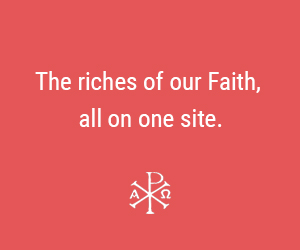Located about 31 miles north of Assisi is the scenic hill town of Gubbio. Known for the largest Christmas tree in the world (each year, lights on Mt. Inigo above the old town are illuminated in the form of a tree), it is also associated with St. Francis, and has an incorruptible saint.
St. Francis and the wolf
Today Gubbio is easily accessible from Assisi on a newly constructed highway. In St. Francis’s day, there was an old rocky road. Today the path he took has been converted into a walking trail known as the “Sentiero della Pace” (trail of peace).
Those familiar with the life of St. Francis of Assisi know that he had a famous encounter with a wild wolf in Gubbio.
In the lower area of the town is a Franciscan church, the Church of San Francesco. It was built in the second half of the 13th century over the house of a family that welcomed St. Francis after he left Assisi and chose a life of poverty. Part of the wall of the house is preserved within the church.
In front of the church is a large bronze sculpture of St. Francis and a wolf. It recalls an event that took place in Gubbio (see Little Flowers of St. Francis, Chapter 21). According to the tale, a ferocious wolf was terrorizing the townspeople of Gubbio. Francis went out to meet the beast, made the sign of the cross, and tamed it. He then brought it into town and made the people promise to feed the wolf and care for it which they did until its natural death.
The story of Francis and the wolf can be considered an allegory for Franciscan peacemaking. However, in 1873, a sarcophagus containing the bones of an animal, probably a wolf, was discovered in a church in Gubbio. The tomb is still visible, though the skeleton has been lost.
Like Assisi, Gubbio is a well-preserved medieval town with characteristic cobblestone streets, alleyways, and restored buildings. Down in the valley is an amazingly preserved Roman amphitheater dating from the 1st century BC, second only in size to the Coliseum in Rome.
Visit the Basilica of St. Ubald
Perhaps the highlight of Gubbio is a visit to the Basilica of St. Ubald. High above the town, it preserves the incorrupt remains of Gubbio’s patron saint. Though little-known outside of the area, the 12th-century Bishop Ubaldo was renowned for his patience and gentleness. Following his death in 1160, many miracles were attributed to his intercession.
Most visitors and pilgrims take a scenic cable car to the top of the mountain to the basilica. Otherwise, the people of Gubbio have a more dramatic way to arrive at their beloved basilica: the feast and race of the “candles.”
Each year on the feast of St. Ubald, four teams of young men race up the mountainside carrying 30-foot, tree-trunk like, wooden “candele” (candles). Before the race, the “candles” are crowned with statues of saints and paraded around the town. It is a race going back to the Middle Ages.
Saint Ubaldo is patron saint of people with autism, sick children, those with obsessive compulsive disorders, and the municipalities of Gubbio and Montovi, Italy.


